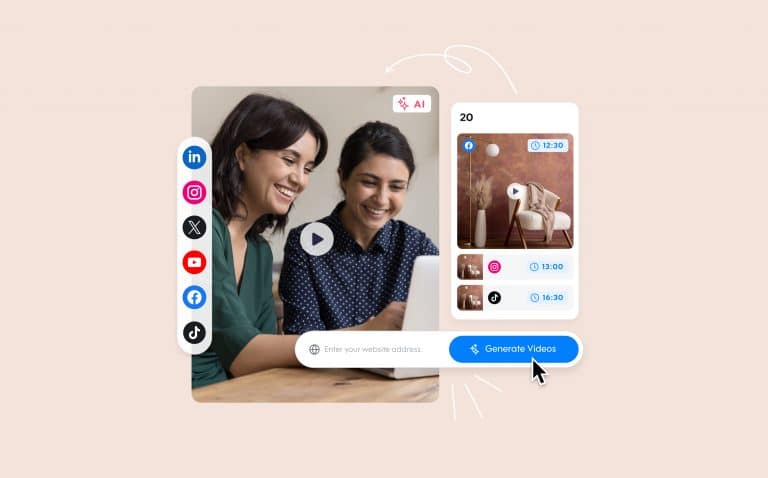
New Study: 2019 Promo.com Online Video Statistics and Trends [Infographic]
The so-called “pivot to video” is in full swing, and it’s not all that surprising.
Consider these two factors:
- Video has become the most effective form of marketing.
- Consumers love watching videos.
There’s obviously a connection there, but obvious is no good for a marketer—you want the data! And we have it.
The team at Promo.com conducted a study of 500 individuals and asked them about their online video-watching habits.
- We learned a ton about when, where, and how people watch videos.
- We learned about their preferences for videos such as length, sound, captions, and more.
- Most importantly – we learned about how watching online videos drives their actions.
With 2019 just about in the books, let’s take a look back at the data to see where video marketing is headed for 2020 based on 500 responses from viewers like you. We present to you: 2019 Promo.com Online Video Statistics and Trends.
Bringing video marketing into focus in 2020
If you’re reading this, you’re a video marketer. Maybe you’re a seasoned pro, maybe you’re just starting out, but video is no longer a piece you can bolt on to your marketing strategy—it’s an integral part of every campaign.
But you’re also a consumer of marketing videos, and this gives you a unique opportunity to observe video marketing as both predator and prey. You can’t just create videos for yourself; you need to know what the rest of us want in an online video.
And that’s exactly what we have for you today. For our annual video marketing study, we asked 500 people in-depth questions about their video consumption habits. At a higher level, here’s a sneak peek at some of the more interesting data points from our study:
- 49% watch over 5 videos per day (up from 44% in 2018)
- 67% use YouTube as their go-to for online video
- 71% prefer to watch videos with the sound ON
- 79% find video ads relevant to them
- 80% watch Stories
But there’s more.
To help you visualize the key data points from our study, we created this infographic. We also broke down out various sections (below the infographic) with our analysis, so don’t forget to check it out.
Without further ado, 2019 Promo.com Online Video Statistics and Trends:

Find anything interesting? We sure did! Let’s zoom in on a couple of the points above provide some analysis:
People spend the most time on Facebook
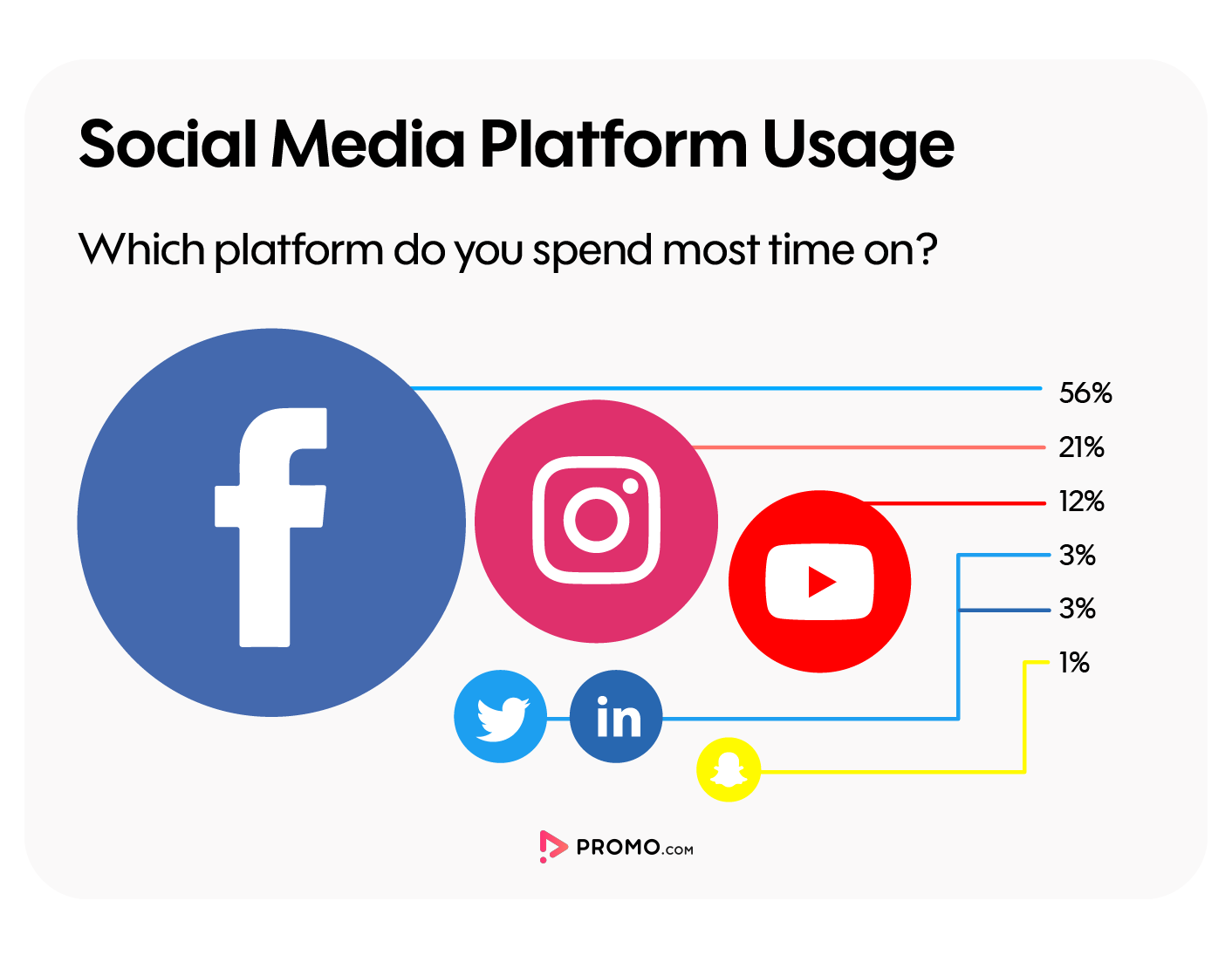
No surprise here—Facebook dominated all other platforms as the preferred platform users reported spending time on:
- Facebook: 56%
- Instagram: 21%
- YouTube: 12%
- Twitter: 3%
- LinkedIn: 3%
- Snapchat: 1%
This is consistent with our study from last year, as well as the global usage of social media networks. Facebook currently leads the way with 2.4 billion monthly active users.
This is likely the cumulative cause of several different features and qualities of the largest social network, but a few things about Facebook particularly stand out when thinking about its usage:
1. Utility
There’s quite a bit you can do on Facebook—find friends, read news, instant message, write comments, view videos, make payments, register for events…
No other platform offers the same amount of utility.
2. Stickiness
If you’re having a conversation (or perhaps a spirited debate) in the comments of a Facebook post, you’ll be drawn back into that conversation every time the red notification pops up on your phone or desktop.
3. Social engineering
Many people use Facebook to ‘kill time’ and the platform is designed to encourage that in every way. From suggested videos to ads targeted toward your interests, the designers at Facebook have made it a pleasant area to virtually ‘hang out.’
This is not to say that Facebook should be the only platform you focus on—far from it. Let your audience guide you toward the most appropriate channels, but understand that from our research, LinkedIn, Snapchat, and Twitter represent only a combined 7% of the public’s preference for where they spend their time.
Actionable takeaway from the data
Upload your videos natively to Facebook—don’t use a YouTube or Vimeo link. Uploading natively will give you several advantages over using a third-party video streaming service:
- Your videos will be eligible for “Suggested Videos” which increases their reach
- You can access more robust analytics for native videos
- Your videos will look more professional due to using the proper video specifications
YouTube is the go-to place to watch video

When it comes to watching video specifically, however, YouTube dominates, which is to be expected. Where would you go if you wanted to learn how to tie a tie or boil an egg?
67% of the audience we surveyed named YouTube as their go-to resource for watching online video, which is up from 41% from the 2018 study.
Facebook accounts for 26% of this audience, down from 47%, while Instagram comes in at 6%.
Actionable takeaway from the data
While YouTube can certainly be used as a promotional tool, especially the ads platform, it really differentiates itself from the other platforms when used to provide information. Since users are going to YouTube specifically to watch a video, you have a much more ‘captive’ audience that will entertain longer videos. Consider loading your YouTube channel with tutorials, product demos, and reviews. Bonus points for categorizing your videos into playlists.
People are watching more online videos every day

If there is any question of whether video consumption is still trending upward, this next statistic lays that to bed for good.
49% of people surveyed watch over 5 videos a day.
That’s up from 44% last year. And that appears to be the majority, considering only 15% of people watch less than 2 videos per day.
More than 400 minutes of video are uploaded to YouTube every minute, and while it’s impossible to determine just how many videos exist on the video-watching platform, we know that audiences watch more than a billion hours of video every day.
Also worth noting—10% of our survey respondents said they watch “too many videos to count” every day.
Actionable takeaway from the data
Don’t put all your eggs in one basket, so to speak—create multiple videos with different subject matter, format, and length.
Should you use sound or subtitles? Both.

We have heard for a couple of years now that people are watching videos—especially on mobile—without sound. When we asked 500 people this year that question, however, we got a surprising result:
71% of respondents said they watch videos with the sound ON. Only 15% said they prefer to watch with the sound off.
This is 100% conjecture, but could this have anything to do with the ubiquity of wireless earbuds such as Apple Airpods, introduced in December of 2016? While it’s purely a conspiracy theory at this point, it’s hard to ignore just how darn convenient those things are…
But while consumers in our study showed a preference for watching videos with the sound on, that hasn’t stopped them from craving subtitles:
- 46% prefer subtitles
- 33% do not care for subtitles
- 21% have no opinion
Actionable takeaway from the data
Cover all your bases by providing subtitles—or on-screen text—in all of your videos. After all, 67% of respondents like to read them. Give the people what they want!
While your videos should work even without sound, they should work even better with the sound on.
80% of people surveyed watch Stories
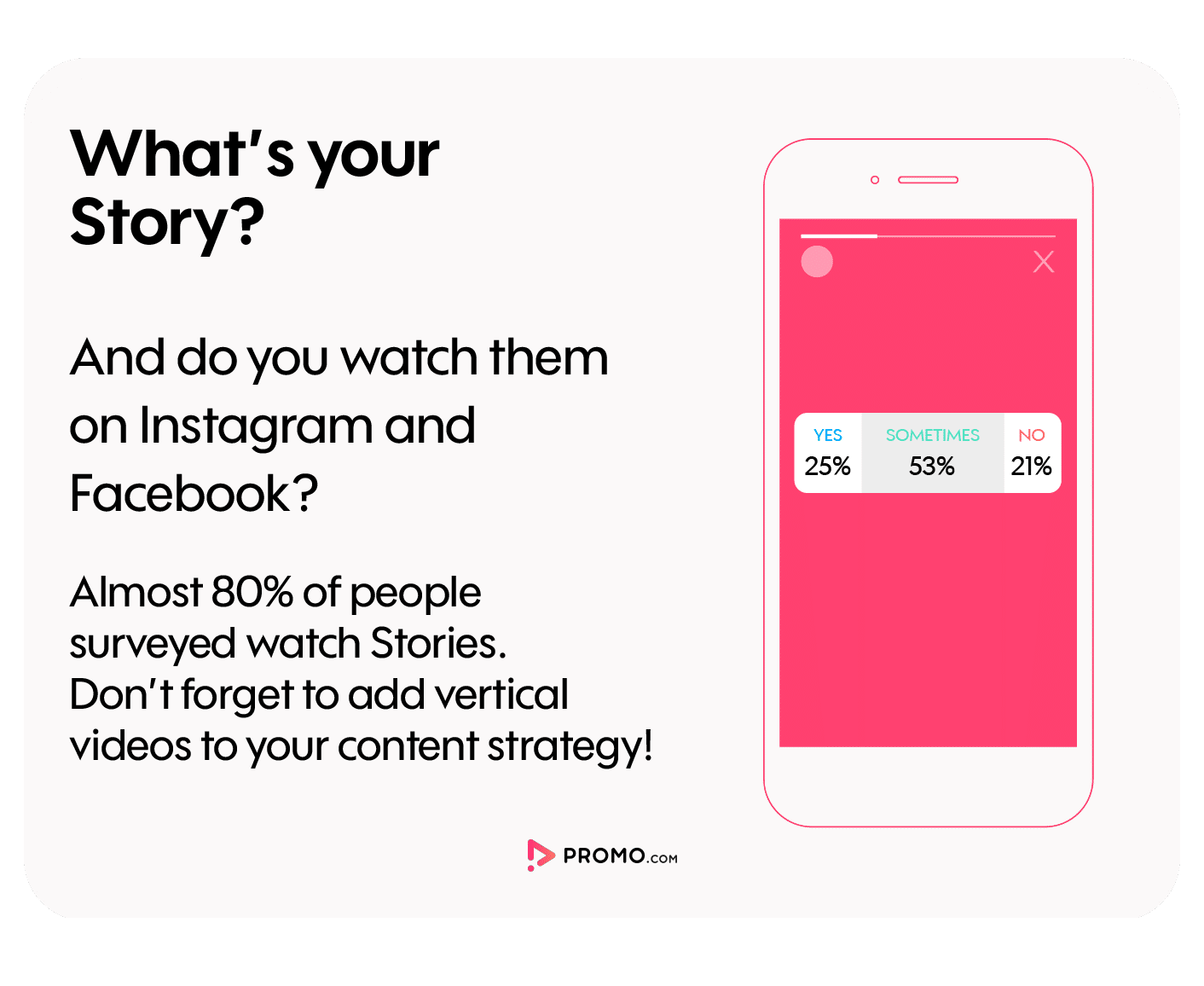
More than half of people surveyed watch Facebook and Instagram Stories “sometimes,” but 25% responded that they watch them “all the time.”
There are plenty of people out there who are rarely browsing the Instagram feed, showing an obvious preference for the Stories format. Instagram seems to be aware of this, as it has built-in a UI feature that allows people to share their newest post via Stories—this helps people who don’t use the feed find new content.
Actionable takeaway from the data
When it comes to using the Facebook and Instagram Stories placement, hit your audiences with the ol’ 1-2:
- Format your videos for vertical viewing
- Plan an engaging, chronological Story broken up into several short clips
Ads are landing well with consumers
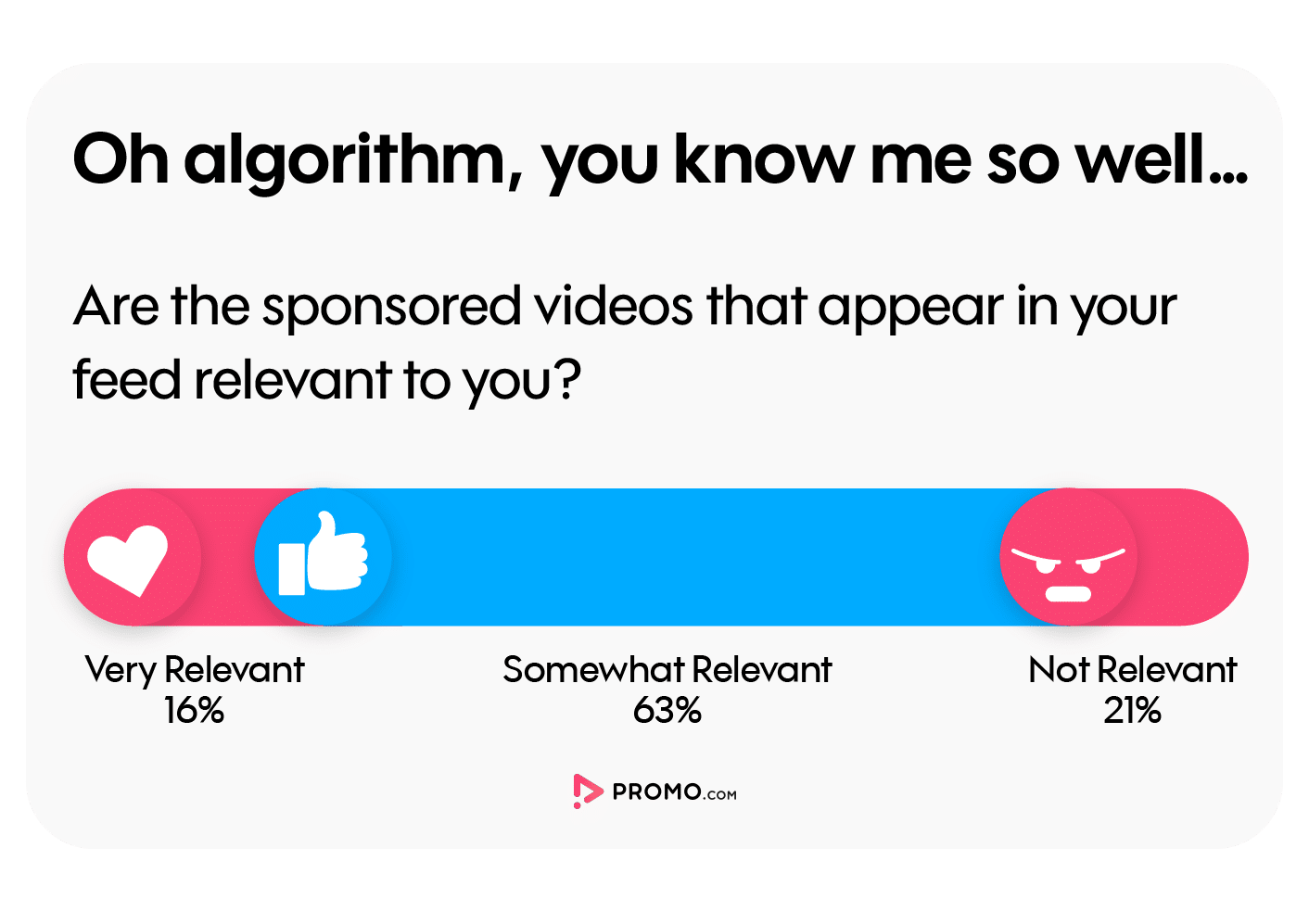
79% of people surveyed find video ads very relevant or somewhat relevant to them.
Organic reach on Facebook has been dead and buried for several years now. If you’re looking to drive business results such as traffic, leads, or online sales, you’ll need to use ads. Perhaps this is just a ploy by the largest social network to make a ton of money, or perhaps there’s some truth to the company line that there’s simply too much content being produced to show you everything.
Either way, the upside is that if you are using ads, our study shows that people are receptive to them.
Actionable takeaway from the data
Make sure to take the time to write a compelling post copy to accompany your videos. Most people (85%, to be exact) read the text above your video “all the time” or “often.”
Need some help writing great ads? We have your back:
- Facebook Advertising: The Complete Guide
- Instagram Advertising: The Complete Guide
- YouTube Advertising: The Complete Guide
- Twitter Advertising: The Complete Guide
- LinkedIn Advertising: The Complete Guide
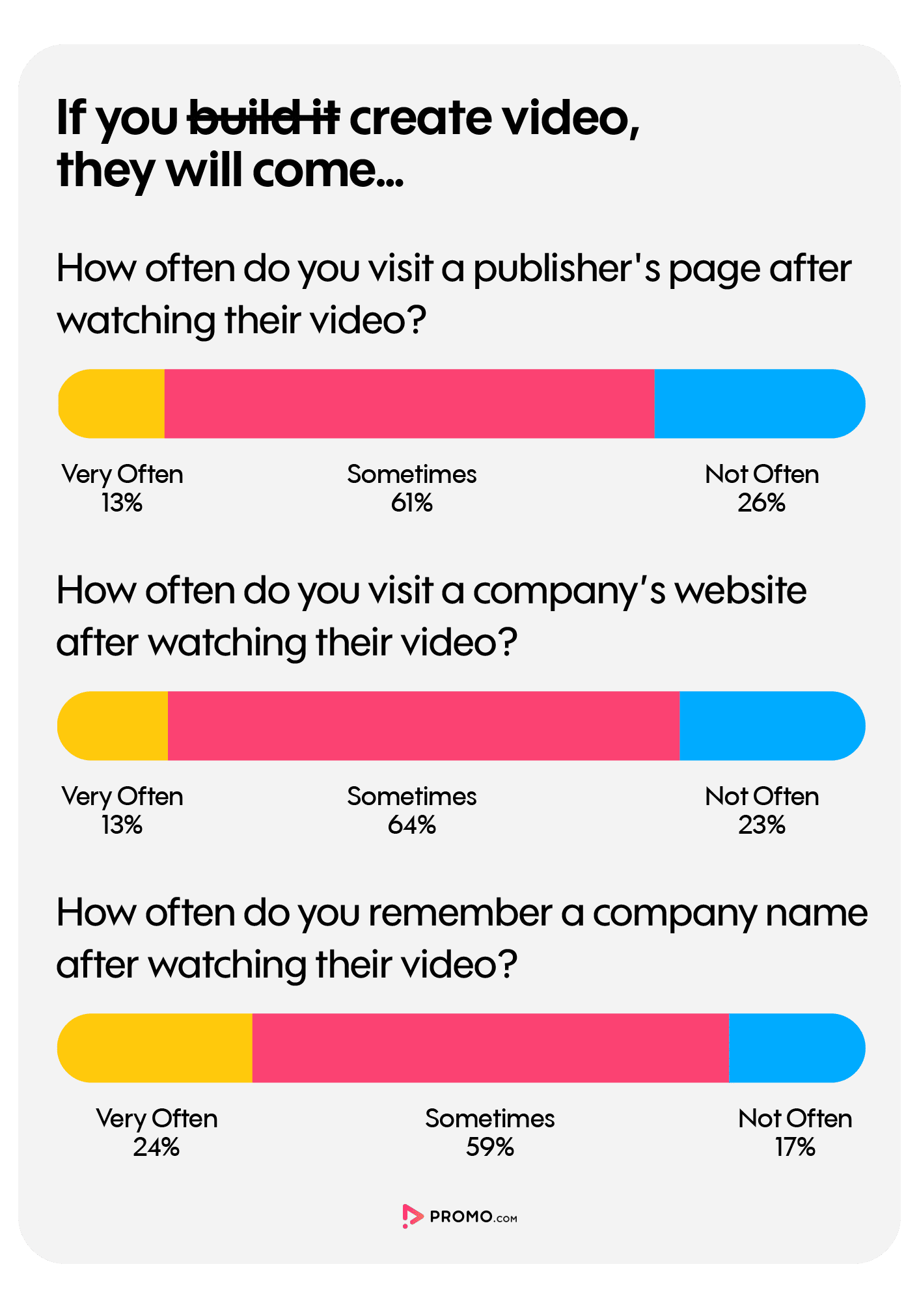
Watching video drives consumer action
Can video help accomplish your business goals?
The best way to answer this is to look at what actions viewers take after they watch online videos, and the results from our study do not disappoint.
61% of respondents will “sometimes” visit the publisher’s social media page after watching a video, while 13% will “very often” click through to the page.
But the viewers’ actions aren’t limited to activity on social media. Many viewers are willing to check out a website after viewing an online video, as proven by the response to this question:
How often do you visit a company’s website after watching their video?
- Very often: 13%
- Sometimes: 64%
- Not often: 23%
But we’re not done! Videos can also work upstream for brand recognition. 59% of respondents will “sometimes” remember a brand name after watching a video, while a shocking 24% of people will “very often” remember a company’s name after the video.
Actionable takeaway from the data
Since people are willing to continue to engage with your brand after watching your video, think of all the ways your video will payoff if you embed it on your website, landing page, or blog. Give them clear next steps to building a relationship with your company; whether through an effective landing page, an email subscription, or another video!
About this study
Promo.com is a marketing video maker, enabling the creation of stand-out videos for ads, social, websites, blogs, and more. We believe that video is the future (and present!) of marketing, but even more importantly, we believe in basing our strategies on data.
That’s why we reached out to over 500 people globally to complete this study.
Here’s a bit more information about survey respondents:
- Gender split was 44% female and 56% male
- Age range from teenage to senior (all ages)
- 10% were aged 24 or younger
- 44% were aged 25-44
- 42% were aged 45 to 64
- 3% were over 65
For more information about the findings, media requests, or republishing requests, please contact:
Hila Shitrit, VP Communications, Promo.com
Ready to start making videos for your business?


